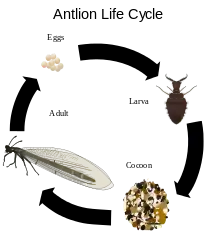Distoleon tetragrammicus
Distoleon tetragrammicus is a species of antlion in the subfamily Myrmeleontinae.[1][2][3]
| Distoleon tetragrammicus | |
|---|---|
 | |
| Adult of Distoleon tetragrammicus | |
| Scientific classification | |
| Domain: | Eukaryota |
| Kingdom: | Animalia |
| Phylum: | Arthropoda |
| Class: | Insecta |
| Order: | Neuroptera |
| Family: | Myrmeleontidae |
| Genus: | Distoleon |
| Species: | D. tetragrammicus |
| Binomial name | |
| Distoleon tetragrammicus (Fabricius, 1798) | |
| Synonyms | |
| |
Distribution
Distoleon tetragrammicus is widespread in the western Palearctic realm and it is present in most of Southern Europe and in North Africa.[4][5]
Habitat
This species can be found in a wide range of habitats, from coastal dunes to mountain forests, mainly in arid and sandy areas, in oak and pine forests and in various calcareous wasteland with minimum moisture. The larvae avoid exposed sites as coastal dunes.[6]
Description

The adults of Distoleon tetragrammicus greatly resemble dragonflies or damselflies. They have a wingspan of about 75 millimetres (3.0 in). The front wing can reach a width of 26–40 millimetres (1.0–1.6 in).[6] They have thick, prominent, apically clubbed antennae, a long, narrow abdomen and two pairs of long, transparent, multiveined wings, with some brown and opaque spots.[7] This species is sometimes confused with Myrmeleon formicarius.
The larvae do not look anything like adults. The length of a fully grown larva is typically 12–22 millimetres (0.47–0.87 in).[8][9] The basic body color is dark brown with darker markings. The head is dark brown. The strong dark brown mandibles do not show long bristles outside the margins. Pronotum is covered by large black setae and short bristles. The dorsal side of abdomen has a series of circular markings and a characteristic dorsal median stripe. Mesothoracic and abdominal spiracles are brown. Legs may be yellowish or whitish.[4]
Biology

The adults of Distoleon tetragrammicus appear in the middle of the summer and fly from June to August.[6] They are attracted to light. The life cycle begins with oviposition by the female into sand. Larvae of this species don't build craters or pit traps. They live buried in dry ground and may be errant. They are voracious predators, feeding on small insects and other small arthropods that they catch with their powerful jaws. After one year the larva retreats into a cocoon and metamorphoses into an adult.[10]
References
- Zicha, Ondrej. "BioLib: Biological library". www.biolib.cz.
- V.A. Krivokhatsky Catalogue of antlion collection (Neuroptera, Myrmeleontidae)
- "Catalogue of Life - 2011 Annual Checklist :: Species details". www.catalogueoflife.org.
- BADANO D. & PANTALEONI R. A., 2014. – The larvae of European Myrmeleontida
- "Fauna Europaea". fauna-eu.org.
- "Neurotteri" (PDF).
- "Hormiga león (Distoleon tetragrammicus) - Institut d'Estudis Catalans". Archived from the original on 2016-03-04. Retrieved 2015-11-02.
- Acevedo, F.; Monserrat, V.J.; Badano, D. (2013). "Comparative description of larvae of the European species of Distoleon Banks: D. annulatus (Klug, 1834) and D. tetragrammicus (Fabricius, 1798) (Neuroptera, Myrmeleontidae)". Zootaxa. 3721: 488–94. doi:10.11646/zootaxa.3721.5.4. PMID 26120688.
- "[Distoleon tetragrammicus] Larve préhistorique - Le Monde des insectes". www.insecte.org.
- Satar, A.; et al. (2006). "Rearing the larval stages of Distoleon tetragrammicus (Fabricius, 1798) (Neuroptera: Myrmeleontidae) from egg to adult, with notes on their behaviour" (PDF). Zootaxa. 1371: 57–64. doi:10.11646/zootaxa.1371.1.5.
Bibliography
- Michael Chinery, Insectes de France et d'Europe occidentale, Paris, Flammarion, août 2012, 320 p. (ISBN 978-2-0812-8823-2), p. 104-105
- Bollettino dell'Istituto di entomologia "Guido Grandi" della Università degli studi di Bologna, Vol. 48-49, Tip. Compositori, 1994.
- Oswald, J. D. (2007). Neuropterida Species of the World.
- Navás, L. (1921) Sur des Névroptères nouveaux ou critiques. Troisème [III] série., Annales de la Société Scientifique de Bruxelles 40(pt. 2):225-232.
- Navás, L. (1914) Neurópteros nuevos o poco conocidos (Tercera [III] serie)., Memorias de la Real Academia de Ciencias y Artes de Barcelona (3)11:193-215.
- Eversmann, E. (1841) Quaedam insectorum species novae, in Rossia orientali observatae, nunc descriptae et depictae., Bulletin de la Société Impériale des Naturalistes de Moscou 14:351-360.
- Olivier, G. A. (1811) Encyclopedie méthodique. Histoire naturelle. Vol. 8 (Insectes). Paris.,
- Fabricius, J. C. (1798) Supplementum entomologiae systematicae. Hafniae.,